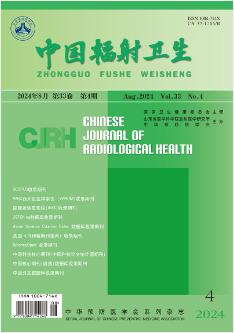Analysis on application of nuclear technology and radiation workers’ occupational health management in non-medical institutions in Huai’an City
引用次数: 0
Abstract
Objective To investigate and analyze the current situation of nuclear technology utilization and radiation workers’ occupational health management in non-medical institutions in Huai’an City, and to strengthen the prevention and control of occupational radiation diseases. Methods 37 non-medical institutions of nuclear technology utilization in Huai’an City were surveyed by questionnaire, including radioisotope and radiation apparatus, personal dose monitoring of radiation workers, implementation of occupational health examination, protective equipment, etc. Results The industry covers manufacturing industry, transportation, warehousing and postal industry, scientific research and technical service industry, residential service, repair and other service industries, 0 class I radiation device, 15 class II radiation devices, 67 class III radiation devices; 0 class I and II radiation sources, 1 class III radiation device, 16 class IV radiation sources, 51 class V radiation sources, 1 unsealed radioactive material Class B workplace; 493 radiation workers, 90.5% with certificates, 85.4% with personal dose monitoring rate, rate of 37.8% with radiation protection monitoring equipment, and 68.0% with occupational health examination rate. It has 13 institutions equipped with personal protective equipment, 23 with dose alarming devices and 14 with radiation protection monitors. 30 radiation workplace tests have been carried out in the past two years. Conclusion The occupational health management of radiation workers in non-medical institutions is weak. At present, the responsibility of occupational health supervision has been assigned to the health department. Therefore, the health administrative department should strengthen the supervision of non-medical nuclear technology utilization institutions and improve the emergency mechanism of radiation emergencies in Huai’an city. 摘要:目的 调查分析淮安市非医疗单位核技术利用及放射工作人员职业健康管理现状, 加强职业性放射性疾病的 预防与控制。 方法 编制调查问卷方式对淮安市37家核技术利用非医疗机构进行普查, 包括射线装置和放射源、放 射工作人员个人剂量监测、职业健康检查开展情况、防护设备配备等内容。 结果 行业覆盖制造业、交通运输、仓储和 邮政业, 科学研宄和技术服务业, 居民服务、修理和其他服务业;I类射线装置0台、II类15台、III类67台;I类、II类 放射源0枚, III类1枚, IV类16枚, V类51枚;非密封放射性物质乙级工作场所数1个。放射工作人员493人, 持证 占比90.5%, 个人剂量监测率85.4%, 辐射防护监测仪配备率37.8%, 职业健康检查率68.0%;配备个人防护用品 13家, 配备剂量报警仪23家, 配备辐射防护监测仪14家;近2年内开展过放射工作场所检测30家。 结论 非医疗机 构对放射工作人员职业健康管理薄弱, 目前职业健康监管职责己划归卫生部门, 卫生行政部门应加强对非医疗核技术 利用机构的监管, 健全我市放射突发事件的应急机制。淮安市非医疗机构核技术应用与辐射工作人员职业健康管理分析
目的调查分析淮安市非医疗机构核技术利用及辐射工作人员职业健康管理现状,为加强职业病防治提供依据。方法采用问卷调查的方法,对淮安市37家核技术利用非医疗机构进行放射性同位素及辐射仪器、辐射工作人员个人剂量监测、职业健康检查实施情况、防护装备等调查。结果行业涵盖制造业、交通运输、仓储邮政业、科研技术服务业、住宅服务、维修等服务业,一类辐射装置0个,二类辐射装置15个,三类辐射装置67个;一、二类辐射源0个,三类辐射装置1个,四类辐射源16个,五类辐射源51个,乙类工作场所未密封放射性物质1个;辐射工作人员493人,持证上岗率90.5%,个人剂量监测率85.4%,辐射防护监测设备配备率37.8%,职业健康检查率68.0%。13个机构配备了个人防护装备,23个机构配备了剂量报警装置,14个机构配备了辐射防护监测仪。过去两年进行了30次工作场所辐射测试。结论非医疗机构辐射工作人员职业健康管理薄弱。目前,职业卫生监督的职责已划归卫生部门。因此,卫生行政部门应加强对非医疗核技术利用机构的监管,完善淮安市辐射突发事件应急机制。摘要:目的 调查分析淮安市非医疗单位核技术利用及放射工作人员职业健康管理现状, 加强职业性放射性疾病的 预防与控制。 方法 编制调查问卷方式对淮安市37家核技术利用非医疗机构进行普查, 包括射线装置和放射源、放 射工作人员个人剂量监测、职业健康检查开展情况、防护设备配备等内容。 结果行业覆盖制造业,交通运输,仓储和邮政业,科学研宄和技术服务业,居民服务,修理和其他服务业;我类射线装置0台,II类15台,第三类67台;我类,II类放射源0枚,第三类1枚,第四类16枚,V类51枚;非密封放射性物质乙级工作场所数1个。放射工作人员493人,持证占比90.5%,个人剂量监测率85.4%,辐射防护监测仪配备率37.8%,职业健康检查率68.0%;配备个人防护用品13家,配备剂量报警仪23家,配备辐射防护监测仪14家,近2年内开展过放射工作场所检测30家。结论 非医疗机 构对放射工作人员职业健康管理薄弱, 目前职业健康监管职责己划归卫生部门, 卫生行政部门应加强对非医疗核技术 利用机构的监管, 健全我市放射突发事件的应急机制。
本文章由计算机程序翻译,如有差异,请以英文原文为准。
求助全文
约1分钟内获得全文
求助全文
来源期刊
CiteScore
0.80
自引率
0.00%
发文量
7142
期刊介绍:
Chinese Journal of Radiological Health is one of the Source Journals for Chinese Scientific and Technical Papers and Citations and belongs to the series published by Chinese Preventive Medicine Association (CPMA). It is a national academic journal supervised by National Health Commission of the People’s Republic of China and co-sponsored by Institute of Radiation Medicine, Shandong Academy of Medical Sciences and CPMA, and is a professional academic journal publishing research findings and management experience in the field of radiological health, issued to the public in China and abroad. Under the guidance of the Communist Party of China and the national press and publication policies, the Journal actively publicizes the guidelines and policies of the Party and the state on health work, promotes the implementation of relevant laws, regulations and standards, and timely reports new achievements, new information, new methods and new products in the specialty, with the aim of organizing and promoting the academic communication of radiological health in China and improving the academic level of the specialty, and for the purpose of protecting the health of radiation workers and the public while promoting the extensive use of radioisotopes and radiation devices in the national economy. The main columns include Original Articles, Expert Comments, Experience Exchange, Standards and Guidelines, and Review Articles.

 求助内容:
求助内容: 应助结果提醒方式:
应助结果提醒方式:


